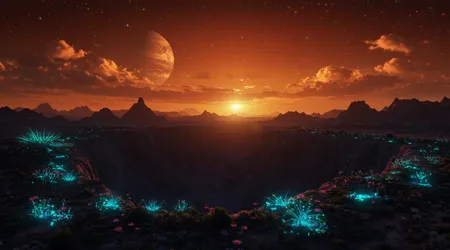Life on Super-Earths: Could We Survive There?

Life on super-earths captivates our imagination, blending science fiction with cutting-edge astronomy. These massive, rocky exoplanets, orbiting distant stars, challenge our understanding of habitability.
Anúncios
Could humans ever thrive on such worlds? This question drives research into their atmospheres, gravity, and potential ecosystems.
Let’s explore the realities, possibilities, and hurdles of surviving on super-earths, grounded in the latest discoveries.
From atmospheric chemistry to gravitational challenges, we’ll unpack what makes these planets both tantalizing and treacherous. Ready to dive into the cosmos?
Super-earths, first identified in 1992 with the discovery of planets orbiting a pulsar, have since been cataloged in thousands by missions like Kepler and TESS.
Unlike our Earth, these planets are larger, often 1.5 to 10 times its mass, yet still rocky. Their diversity some shrouded in thick gas, others barren sparks debate about their potential to host life.
Are we chasing a cosmic mirage, or could super-earths be humanity’s next frontier? This article navigates the science, offering a clear-eyed look at survival prospects.
What Are Super-Earths, and Why Do They Matter?
Super-earths are rocky exoplanets, bigger than Earth but smaller than Neptune. Their size and composition make them prime candidates for habitability studies.
Found in diverse orbits, some lie in their star’s habitable zone, where liquid water might exist. The discovery of Gliese 581g in 2010, a potential super-earth in this zone, ignited global fascination. These worlds could redefine our search for extraterrestrial life.
Unlike gas giants, super-earths have solid surfaces, but their atmospheres vary widely. Some have thin, Earth-like air; others are cloaked in dense hydrogen.
This diversity complicates habitability assessments. A planet like Kepler-452b, dubbed “Earth’s cousin,” orbits a sun-like star, hinting at familiar conditions.
++ The Goldilocks Zone: Why It’s Not the Only Place Life Could Exist
Yet, its true nature remains elusive, as we lack direct surface data. Could such worlds support human colonies?
The stakes are high. Super-earths challenge our assumptions about life’s requirements. Studying them refines our tools for detecting biosignatures chemical hints of life.
Missions like the James Webb Space Telescope (JWST), launched in 2021, are now probing these planets’ atmospheres. Their findings could reshape our cosmic perspective, revealing whether life on super-earths is plausible.

The Atmosphere Puzzle: Can We Breathe There?
Atmospheric composition is critical for survival. Super-earths often have thicker atmospheres than Earth due to stronger gravity.
This could trap gases like carbon dioxide or methane. JWST’s 2023 analysis of K2-18b revealed water vapor and methane, hinting at possible oceans. But dense atmospheres might suffocate humans, requiring advanced life-support systems.
Oxygen is a key concern. Earth’s atmosphere, 21% oxygen, supports human respiration. Super-earths may lack this balance, with some dominated by toxic gases.
For example, a hydrogen-rich atmosphere, common on larger super-earths, would be unbreathable.
Terraforming altering a planet’s atmosphere remains speculative, demanding centuries of technological leaps. Could we adapt to such alien air?
Also read: How Astronomers Detect Planets They Can’t Even See
Protection from radiation is another hurdle. Super-earths orbiting close to their stars, like those around red dwarfs, face intense stellar flares.
A thick atmosphere might shield the surface, but thin ones leave it vulnerable. Earth’s magnetic field deflects solar radiation; super-earths may need artificial shields. Survival hinges on solving these atmospheric riddles.
Gravity’s Grip: Could Our Bodies Cope?
Higher mass means stronger gravity on super-earths, often 1.5 to 3 times Earth’s. This impacts human physiology profoundly. Increased gravity stresses bones, muscles, and organs.
A 2021 study in Astrobiology found that humans on a 2g planet would face chronic fatigue and heart strain. Could our bodies adapt to such conditions?
Short-term exposure might be manageable with training, akin to astronauts preparing for space. But long-term living could require genetic or biomechanical enhancements.
Imagine a colony where every step feels like wading through molasses an analogy for gravity’s relentless pull. Exoskeletons or low-gravity habitats could help, but these are distant prospects. Physical adaptation remains a formidable barrier.
Read more: Could Alien Life Be Based on Something Other Than Carbon?
Gravity also affects infrastructure. Buildings on a 2g super-earth would need robust materials to withstand added weight. Transport systems, from rovers to aircraft, would require redesign.
For example, a rover on a high-gravity planet might need reinforced wheels to avoid collapse. These challenges demand innovative engineering to make life on super-earths feasible.
Water and Ecosystems: The Building Blocks of Life
Liquid water is essential for life as we know it. Some super-earths, like TOI-1452b, show signs of water vapor, suggesting possible oceans. But water alone isn’t enough.
Earth’s ecosystems thrive on a delicate balance of nutrients and microbes. Could super-earths host similar systems, or would alien biochemistry dominate?
Temperature is a limiting factor. Super-earths in the habitable zone may still have extreme climates. A planet locked tidally to its star, like Proxima Centauri b, might have one scorching side and one frozen.
Life might exist in a twilight zone, but human survival would require insulated habitats. Adapting to such extremes tests our ingenuity.
Potential ecosystems pose another question. If life on super-earths exists, it might be microbial or radically different from Earth’s.
For instance, extremophiles on Earth thrive in harsh conditions, like deep-sea vents. Could super-earths harbor similar life?
Colonists might need to coexist with or harness such organisms, reshaping our approach to survival.
Technological Hurdles: Can We Build a Home There?
Colonizing super-earths demands advanced technology. Atmospheric processors, like those envisioned in science fiction, could filter toxic gases.
But current tech, like NASA’s Mars habitat prototypes, is rudimentary by comparison. Building a self-sustaining colony requires breakthroughs in energy, food production, and waste recycling.
Energy is a bottleneck. Super-earths around dim red dwarfs may lack sufficient sunlight for solar power. Nuclear reactors or geothermal systems could work, but transporting them across light-years is daunting.
For example, a fusion reactor, still experimental on Earth, would need to be compact and reliable. Can we master such tech in time?
Habitats must also withstand alien conditions. A super-earth with violent storms, like those inferred on HD 189733b, would need reinforced domes.
Food production might rely on hydroponics, as tested on the ISS. These systems, scaled for a colony, would face logistical nightmares. Life on super-earths hinges on solving these practical puzzles.
The Ethical and Cultural Question: Should We Colonize?

Beyond science, colonizing super-earths raises ethical dilemmas. If microbial life exists, would human settlement disrupt it?
Earth’s history of colonization shows unintended consequences, like ecological collapse. Could we avoid repeating these mistakes on a cosmic scale?
Cultural adaptation is equally complex. Humans on a super-earth would face isolation, confined to artificial habitats. Imagine a community in a domed city, cut off from Earth’s seasons and skies.
Psychological strain could fracture social cohesion. Rituals, like celebrating Earth holidays, might anchor colonists’ identity. Would that be enough?
The decision to colonize involves weighing risks against benefits. Super-earths could offer resources or a backup for humanity.
But reckless expansion might harm alien ecosystems or strand colonists. Thoughtful planning, guided by ethics, is crucial for sustainable life on super-earths.
The Role of AI and Robotics in Exploration
Artificial intelligence is transforming exoplanet exploration. AI algorithms, like those used by TESS to identify planets, can analyze super-earth atmospheres remotely.
Future missions might deploy AI-driven rovers to map surfaces. Could these tools pave the way for human settlers?
Robotics could handle hazardous tasks. On a high-gravity super-earth, drones might scout terrain, sparing humans physical strain.
For example, a drone swarm could survey a planet’s twilight zone, identifying safe zones for habitats. Such tech reduces risks but requires massive investment.
AI also aids in simulating super-earth environments. Models predict how humans might fare under alien gravity or radiation.
These simulations, like those run by NASA’s Exoplanet Modeling and Analysis Center, guide mission planning. They’re critical for envisioning life on super-earths.
Table: Key Factors for Human Survival on Super-Earths
| Factor | Challenge | Potential Solution |
|---|---|---|
| Atmosphere | Toxic or unbreathable gases | Atmospheric processors, sealed habitats |
| Gravity | High gravity strains human physiology | Exoskeletons, low-gravity living modules |
| Water Availability | Uncertain presence of liquid water | Hydroponics, water recycling systems |
| Radiation | Intense stellar flares | Artificial magnetic shields, thick domes |
| Ecosystems | Alien biochemistry, extreme climates | Insulated habitats, microbial studies |
The Cosmic Perspective: What Super-Earths Teach Us
Studying super-earths reshapes our view of humanity’s place in the universe. Their diversity some Earth-like, others alien forces us to rethink life’s possibilities.
A 2024 Nature study estimated 30% of super-earths in habitable zones might have water. This statistic fuels hope but demands caution.
These worlds also highlight our technological limits. Each discovery, from Gliese 581g to K2-18b, pushes engineering and ethics forward.
Imagine Earth as a lone island in a vast cosmic sea super-earths are distant shores, beckoning yet perilous. They challenge us to innovate responsibly.
Ultimately, super-earths remind us of Earth’s fragility. Exploring them could inspire solutions to our planet’s crises, like climate change.
By pursuing life on super-earths, we learn to cherish and protect our own world, ensuring humanity’s survival here first.
Conclusion: Are Super-Earths Our Future?
The quest for life on super-earths blends wonder with pragmatism. These planets, scattered across the galaxy, offer tantalizing possibilities but daunting challenges.
From unbreathable atmospheres to crushing gravity, survival demands breakthroughs we’re only beginning to imagine.
Yet, each discovery brings us closer to answering a profound question: Can humanity find a second home among the stars?
Science, from JWST’s atmospheric scans to AI-driven exploration, is paving the way. Ethical questions loom large, urging us to tread carefully.
Super-earths aren’t just destinations; they’re mirrors reflecting our ambitions and limits.
As we gaze outward, we must also look inward, refining our technology and values. The journey to super-earths starts here on Earth where we decide what kind of species we’ll become.
Frequently Asked Questions
Q: What makes super-earths different from Earth?
A: Super-earths are larger, rocky exoplanets with stronger gravity and diverse atmospheres, often orbiting different types of stars, unlike Earth’s balanced conditions.
Q: Could humans live on a super-earth today?
A: No, current technology can’t support human survival due to challenges like high gravity, toxic atmospheres, and radiation. Future advancements are needed.
Q: How do we know super-earths might have water?
A: Telescopes like JWST detect water vapor in atmospheres, as seen on K2-18b, suggesting possible oceans, though direct evidence is lacking.
Q: What’s the biggest obstacle to colonizing super-earths?
A: High gravity, which stresses human bodies and infrastructure, poses the greatest challenge, requiring advanced engineering and physiological adaptations.
